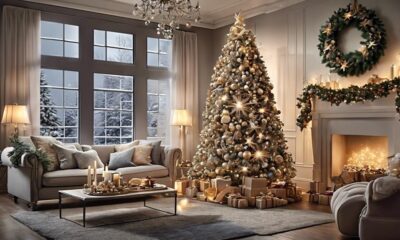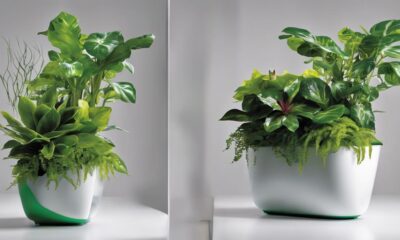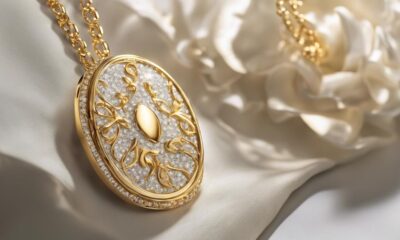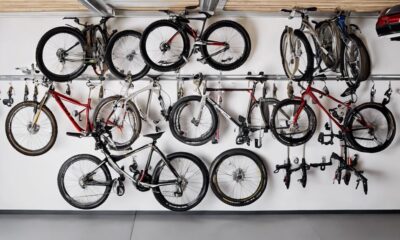Decor
What Can Substitute Coffee

Craving a caffeine kick but want to explore alternatives to coffee? Look no further! In this article, I’ll share evidence-based options that can substitute your beloved brew.
From herbal teas to energy-boosting smoothies, there’s a bevvy of choices to satisfy your taste buds and keep you energized throughout the day.
So, let’s dive into the world of delicious substitutes that will surely captivate your senses and invigorate your mornings.
Key Takeaways
- Herbal teas like yerba mate and matcha can be great substitutes for coffee with less caffeine.
- Yerba mate provides a smoother and sustained energy boost compared to coffee.
- Matcha green tea provides calm and focused energy without jitters.
- Other alternatives to coffee include matcha latte, golden milk, fruit smoothies, chai tea, and hot chocolate.
Herbal Teas
Herbal teas can be a great substitute for coffee. Not only do they offer a wide range of flavors, but they also provide various health benefits.
One popular herbal tea is yerba mate, which originates from South America. Yerba mate is rich in antioxidants, vitamins, and minerals, making it a healthy alternative to coffee. It can improve mental focus, boost energy levels, and enhance digestion.
Another herbal tea that can replace coffee is matcha. Matcha is made from powdered green tea leaves, which are packed with antioxidants. It provides a calm and focused energy without the jitters or crash associated with coffee. Additionally, matcha can be used in various recipes, such as smoothies and desserts, making it a versatile and delicious coffee alternative.
Yerba Mate
When it comes to finding a healthy alternative to coffee, Yerba Mate is a great option to consider. This South American drink is packed with numerous benefits, including its high antioxidant content, ability to boost energy levels, and promote mental focus.
In terms of caffeine content, Yerba Mate falls somewhere between green tea and coffee, making it a suitable choice for those looking for a moderate energy boost without the jitters.
To prepare Yerba Mate, you can use a traditional gourd and bombilla or opt for convenient tea bags, and steep it in hot water for a few minutes before enjoying its rich flavor and invigorating effects.
Yerba Mate Benefits
If you’re looking for a caffeine boost without the jitters, yerba mate might be the perfect substitute for coffee. Yerba mate has a long history, originating from the indigenous Guarani people in South America. This herbal tea is made from the leaves of the yerba mate plant and has been consumed for centuries for its stimulating effects.
• Rich History: Yerba mate has been a staple in South American culture for centuries, with its consumption dating back to ancient times. It was traditionally used by indigenous tribes for its energizing properties and as a social beverage during gatherings.
• Unique Taste: Yerba mate has a distinct flavor profile that is often described as earthy, grassy, and slightly bitter. It can take some time to acquire a taste for it, but many people enjoy its robust and invigorating flavor.
• Smooth Energy: Unlike coffee, yerba mate provides a smoother and more sustained energy boost. It contains a combination of caffeine, theobromine, and theophylline, which work together to provide a balanced stimulation without the jitters or crash often associated with coffee.
Caffeine Content Comparison
To compare the caffeine content, you’ll find that yerba mate typically contains less caffeine than coffee. While coffee is known for its high caffeine content, yerba mate is a popular alternative for those looking to reduce their caffeine intake.
Yerba mate is an herbal tea made from the leaves of the South American holly tree. It has a rich, earthy flavor and is often consumed hot or cold. In comparison, coffee is made from roasted coffee beans and has a strong, bitter taste.
Another alternative to coffee is matcha green tea, which is made from powdered green tea leaves. Matcha contains caffeine, but it also contains an amino acid called L-theanine, which is known to promote relaxation and reduce anxiety.
Therefore, if you’re looking for a beverage with less caffeine, herbal teas like yerba mate or matcha green tea can be great substitutes for coffee.
Yerba Mate Preparation Tips
For a flavorful twist, try adding a squeeze of lemon or a sprig of mint to your yerba mate. These simple additions can enhance the taste and aroma of this traditional South American beverage.
When it comes to brewing techniques, there are a few key tips to keep in mind. First, make sure to use hot (but not boiling) water to steep the yerba mate leaves. This will help to extract the flavors without scorching the leaves. Second, allow the mate to steep for 3-5 minutes before enjoying. This will give the flavors enough time to infuse into the water. Lastly, experiment with different brewing methods like using a gourd and bombilla or a French press to find your preferred taste and strength.
Yerba mate also offers a range of flavor variations, from earthy and grassy to more floral and fruity notes. These variations can be influenced by factors such as the region where the yerba mate was grown and the aging process.
Now, let’s explore another coffee substitute that has gained popularity in recent years: matcha green tea.
Matcha Green Tea
When it comes to matcha green tea, there are several key points to consider.
Firstly, matcha is known for its numerous health benefits, including high levels of antioxidants and potential cancer-fighting properties.
Secondly, while matcha does contain caffeine, the levels are lower compared to coffee, making it a great alternative for those looking to reduce their caffeine intake.
Lastly, matcha’s versatility in recipes is truly impressive, as it can be used in everything from traditional tea preparations to smoothies, baked goods, and even savory dishes.
Health Benefits of Matcha
Did you know that drinking matcha can boost your metabolism and provide you with a steady, long-lasting energy throughout the day? Matcha, a powdered form of green tea, is rich in antioxidants and contains a unique amino acid called L-theanine.
Here are three ways you can incorporate matcha into your daily routine:
-
Start your morning with a refreshing matcha latte. Simply whisk matcha powder with hot water, add your choice of milk, and enjoy a creamy and nutritious beverage.
-
Experiment with matcha recipes, like matcha pancakes or matcha smoothies. These recipes not only add a vibrant green color to your plate but also provide a nutritional boost.
-
Try incorporating matcha into your baking. Matcha can add a unique flavor and vibrant green hue to cookies, cakes, and even ice cream.
By incorporating matcha into your diet, you can enjoy its numerous health benefits and add variety to your daily routine.
Now, let’s explore how matcha’s caffeine levels compare to other beverages.
Caffeine Levels Compared
If you’re looking for a lower caffeine alternative, consider opting for matcha instead of regular green tea. Not only does matcha provide a natural energy boost, but it also offers a range of health benefits. In terms of caffeine levels, matcha contains roughly half the amount of caffeine found in a cup of coffee. To give you a better idea of the caffeine content in various beverages, here’s a comparison table:
| Beverage | Caffeine Content |
|---|---|
| Coffee | 95 mg |
| Matcha | 35 mg |
| Green Tea | 25 mg |
| Black Tea | 47 mg |
| Energy Drink | 80 mg |
As you can see, matcha falls on the lower end of the caffeine spectrum. So if you’re looking for a natural energy booster with less caffeine, matcha is a great choice.
Versatility in Recipes
Now that we have compared the caffeine levels of various substitutes for coffee, let’s explore the versatility of these alternatives in different recipes.
These alternatives can be used not only as standalone beverages but also in a variety of cocktails and alternative breakfast beverages. Here are three examples of how these substitutes can be incorporated into different recipes:
-
Matcha Latte: A popular choice among health-conscious individuals, matcha powder can be mixed with milk or a milk substitute to create a creamy and vibrant green latte. Add a touch of sweetness with honey or maple syrup for a delightful morning pick-me-up.
-
Golden Milk: Turmeric, known for its anti-inflammatory properties, can be combined with warm milk or a milk substitute to create a soothing and aromatic golden milk. Enhance the flavor with spices like cinnamon and ginger, and sweeten with a natural sweetener like agave syrup.
-
Fruit Smoothie: Blend your favorite fruits with a non-caffeinated liquid base such as almond milk or coconut water for a refreshing and nutritious alternative breakfast beverage. Customize your smoothie with a variety of fruits like berries, bananas, and mangoes for a burst of vitamins and antioxidants.
These versatile alternatives offer a wide range of flavors and can easily be incorporated into different recipes to suit your tastes and preferences.
Chai Tea
You might enjoy trying chai tea as a substitute for coffee. Chai tea is a flavorful and aromatic beverage that originated in India and is made by brewing black tea with a mixture of spices and herbs.
It offers several benefits that make it a great alternative to coffee. Chai tea contains less caffeine than coffee, making it a suitable choice for those who want to reduce their caffeine intake. Additionally, the spices used in chai tea, such as cinnamon, cardamom, ginger, and cloves, provide various health benefits. They have been found to have antioxidant and anti-inflammatory properties, promote digestion, and boost the immune system.
There are also different types of chai tea available, such as masala chai, green chai, and rooibos chai, allowing you to choose the one that suits your taste preferences.
Hot Chocolate
When it comes to indulging in a warm and comforting drink, hot chocolate is a delicious option that you won’t want to miss out on. Not only does it provide a satisfying treat, but it also offers several benefits for your health.
Here are some of the reasons why hot chocolate is a great choice:
-
Rich in antioxidants: Hot chocolate contains high levels of cocoa, which is packed with antioxidants that help protect the body against free radicals and reduce inflammation.
-
Mood booster: Hot chocolate stimulates the production of endorphins, commonly known as the ‘feel-good’ hormones, which can enhance your mood and provide a sense of relaxation.
-
Heart-healthy: Studies have shown that consuming hot chocolate in moderation can improve blood flow, lower blood pressure, and reduce the risk of heart disease.
Additionally, hot chocolate can be enjoyed in various ways, from classic recipes to unique variations like peppermint hot chocolate or salted caramel hot chocolate.
Decaffeinated Coffee
If you’re looking for a lower-caffeine alternative, decaf coffee is a great choice for enjoying a warm and comforting drink. Decaffeinated coffee alternatives offer a way to still enjoy the taste and ritual of coffee without the stimulating effects of caffeine.
Decaf coffee is made by removing most of the caffeine from the coffee beans through a process that involves water, solvents, or carbon dioxide. While decaf coffee does contain a small amount of caffeine, it is significantly less compared to regular coffee.
Health benefits of decaffeinated coffee include reduced risk of certain diseases such as type 2 diabetes, Parkinson’s disease, and liver disease. Additionally, decaf coffee contains antioxidants that may have protective effects on the body.
Golden Milk (Turmeric Latte
To enjoy a warming and health-promoting beverage, try golden milk, a delicious turmeric latte that is known for its anti-inflammatory properties. Golden milk is made by combining turmeric with milk, and adding other ingredients such as ginger, cinnamon, and honey for extra flavor.
Here are three reasons why you should consider incorporating golden milk into your routine:
-
Anti-inflammatory benefits: Turmeric, the main ingredient in golden milk, contains a compound called curcumin that has been shown to have potent anti-inflammatory effects in the body. Consuming turmeric regularly may help reduce inflammation and alleviate symptoms of conditions like arthritis.
-
Immune support: Turmeric is also known for its immune-boosting properties. It contains antioxidants that help protect cells from damage and support a healthy immune system.
-
Digestive aid: Golden milk can also aid in digestion. Turmeric has been traditionally used in Ayurvedic medicine to help improve digestion and relieve symptoms of indigestion.
Incorporating golden milk into your daily routine can be a tasty and beneficial way to enjoy the health benefits of turmeric.
Energy-Boosting Smoothies
One way to increase your energy levels is by incorporating energy-boosting smoothies into your diet. These nutritious and delicious drinks are a great alternative to morning coffee and can provide you with a natural and sustained source of energy throughout the day.
Energy boosting juices, such as those made with fruits like bananas, berries, and citrus, are packed with vitamins, minerals, and antioxidants that can help to fight fatigue and improve focus. Adding ingredients like leafy greens, chia seeds, and nut butters can further enhance the energizing effects of your smoothie.
Frequently Asked Questions
Are There Any Health Benefits Associated With Herbal Teas?
Herbal teas offer various health benefits. They can boost immunity, aid digestion, reduce inflammation, and promote relaxation. Different herbal teas have different benefits, so it’s important to choose ones that align with your specific health goals.
What Is the Difference Between Matcha Green Tea and Regular Green Tea?
Matcha vs. Sencha: Which green tea is better for weight loss? When comparing the caffeine content, matcha contains about 3 times more caffeine than regular green tea. However, both can be a good substitute for coffee.
Can Yerba Mate Provide a Similar Energy Boost as Coffee?
Yerba mate and herbal teas are often compared to coffee for their ability to provide energy and focus. While coffee is commonly favored, these alternatives can offer similar alertness and stimulation, making them viable substitutes.
Are There Any Potential Side Effects of Consuming Chai Tea?
Potential side effects of chai tea include digestive issues and caffeine sensitivity. To minimize these effects, it’s important to consume chai tea in moderation and opt for decaffeinated versions.
What Are Some Creative Ways to Prepare and Enjoy Hot Chocolate as a Coffee Substitute?
When it comes to hot beverages, I love exploring alternatives to coffee. Hot chocolate recipes can be a delicious and comforting substitute. Additionally, herbal teas offer a variety of flavors and health benefits.
What Are Some Alternatives to Starbucks Coffee?
Looking for substitute options for starbucks coffee? Look no further! There are numerous alternatives that offer unique flavors and brewing styles. Check out local coffee shops, which often serve handcrafted beverages. Don’t forget about popular chains like Peet’s Coffee, Dunkin’ Donuts, and Tim Hortons. You can also explore specialty coffee brands and try brewing your own coffee at home with various methods such as French press or pour-over.
Conclusion
In conclusion, exploring alternatives to coffee can be a journey of discovering new flavors and experiences.
Just like a compass guiding us through uncharted territory, these substitutes can help us navigate our mornings without relying on caffeine.
Whether it’s the soothing properties of herbal teas or the energizing effects of matcha green tea, there are plenty of options to choose from.
So, let’s set sail on this caffeine-free adventure and see where it takes us.
Bon voyage!
- About the Author
- Latest Posts
Introducing Charles, the Editor in Chief at ByRetreat, whose passion for interior design and editorial excellence elevates every remote workspace to new heights. With his keen eye for detail, impeccable taste, and expertise in design, Charles brings a wealth of knowledge and creativity to the ByRetreat team.
As the Editor in Chief of a renowned lifestyle blog, Charles has honed his skills in curating captivating content and staying up-to-date with the latest trends in interior design. His deep understanding of aesthetics and the power of storytelling through design enables him to create remote workspaces that are not only visually stunning but also rich in personality and meaning.
Decor
How Do I Hang Cue Stick and Balls on Wall for Decor
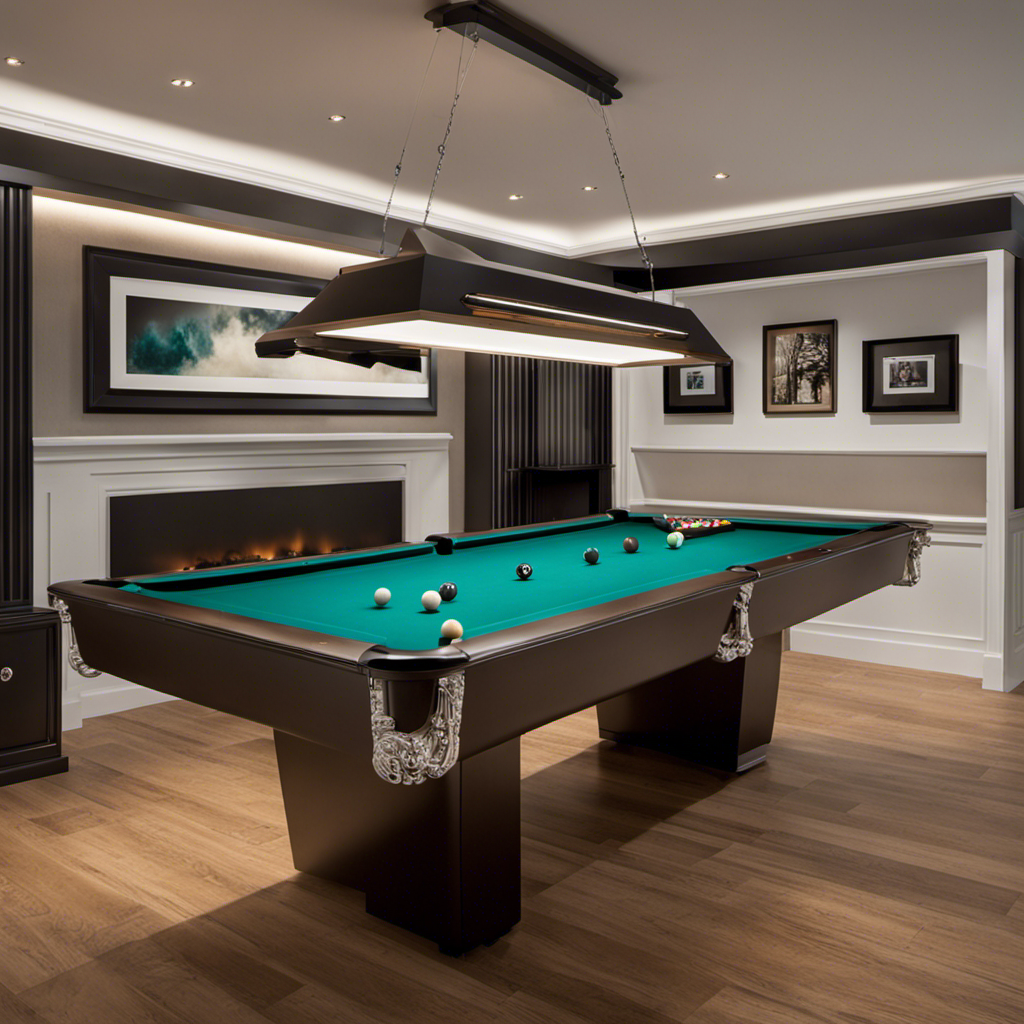
I have always been a fan of distinctive and attention-grabbing decorations, and I recently discovered a fantastic idea for adding a personal touch to my game room.
Picture this: a cue stick and a set of billiard balls hung on the wall, creating a stunning display that showcases my love for the game.
But how do I go about hanging them in a way that looks stylish and professional?
In this article, I’ll guide you through the step-by-step process of hanging a cue stick and balls on the wall for a decor that’s sure to impress.
Key Takeaways
- Consider the size, weight, and material of the cue stick and balls
- Evaluate the aesthetic appeal of the mount and its compatibility with the overall decor style
- Use a compact storage case with compartments for cues, chalk, tip tools, and spare tips
- Measure the ideal height for hanging the cue stick and mark the position for each ball on the wall
Choosing the Right Wall Mount
You’ll want to make sure you choose the right wall mount for hanging your cue stick and balls as decor. When it comes to wall mount options, there are a few factors to consider.
Firstly, you’ll want to think about the size and weight of your cue stick and balls. This will help determine the type of mount that can adequately support them.
Additionally, consider the aesthetic appeal of the mount. There are various styles available, from sleek and modern to rustic and vintage.
It’s also worth considering the material of the mount. For a more traditional look, wood can be a great choice, while metal mounts can add a contemporary touch.
Preparing the Cue Stick and Balls
When it comes to organizing my cue stick and balls, I’ve found a few storage options that work well. From wall-mounted racks to freestanding stands, there are plenty of choices to fit any space.
Additionally, I’ve discovered some unique ball display ideas that not only showcase my collection but also add a touch of style to my game room.
Cue Stick Storage Options
To efficiently store your cue stick, consider using a wall-mounted rack or a freestanding cue stand.
These cue stick storage solutions not only keep your cue organized and easily accessible, but can also add a touch of style to your game room or man cave.
Wall-mounted racks are a popular choice for those looking to create a decorative wall display. They come in various designs and materials, such as wood or metal, and can hold multiple cues, as well as your cue balls.
If you prefer a more portable option, a freestanding cue stand is a great choice. These stands often have a compact design and can be easily moved around when needed.
Whether you choose a wall-mounted rack or a freestanding cue stand, you can store your cue stick in a practical and visually appealing way.
Ball Display Ideas
If you’re looking for a stylish way to showcase your collection, consider using a glass case to display your ball collection. Here are four creative ideas for displaying your balls in a visually appealing way:
-
Floating shelf: Install a floating shelf on your wall and arrange your balls neatly on it. This modern and minimalist approach will give your collection a sleek and sophisticated look.
-
Shadow box: Purchase a shadow box display case and arrange your balls inside. The transparent glass will allow you to see your collection while protecting it from dust and damage.
-
Tiered stand: Invest in a tiered stand made specifically for ball display. This will give your collection a unique and eye-catching presentation, with each ball showcased on a different level.
-
Wall-mounted rack: Install a wall-mounted rack with individual slots for each ball. This will not only display your collection beautifully, but also keep it organized and easily accessible.
With these ball storage solutions, your collection will be the center of attention in any room.
Now, let’s move on to organizing cue accessories.
Organizing Cue Accessories
One option for organizing your cue accessories is using a compact storage case. These cases are designed to hold all your cue stick maintenance and cue stick accessories in one convenient place.
With compartments for cues, chalk, tip tools, and even spare tips, a storage case can keep everything organized and easily accessible. The compact size is perfect for traveling to tournaments or simply keeping your cues and accessories neat and tidy at home.
Plus, the sturdy construction ensures that your valuable cue sticks are protected from damage. Whether you’re a casual player or a serious competitor, investing in a storage case is a smart way to keep your cue accessories organized and ready for action.
Measuring and Marking the Wall
First, grab a measuring tape and determine the ideal height and spacing for hanging your cue stick and balls on the wall. To ensure measuring accuracy, make sure the measuring tape is straight and taut against the wall.
Here’s a step-by-step guide to help you with wall preparation:
-
Measure the length of your cue stick and mark the desired height on the wall. This will ensure that your cue stick is easily accessible and at a comfortable height for grabbing.
-
Measure the width of your pool table and divide it by the number of balls you have. This will give you the spacing needed between each ball when hanging them on the wall.
-
Mark the position for each ball on the wall, ensuring that they are evenly spaced and aligned.
-
Use a level to double-check that all your markings are straight and aligned.
Installing the Wall Mount
To properly install the wall mount, you’ll need to carefully follow the instructions provided and ensure that it is securely attached to the designated spot.
Installing hardware can be a daunting task, but with a little knowledge and attention to detail, it can be done seamlessly.
First, gather all the necessary tools and hardware, such as screws, anchors, and a drill.
Positioning the mount correctly is crucial for stability and aesthetics. Use a level and measuring tape to determine the ideal height and distance from other objects. Once you have marked the spot, drill pilot holes and attach the mount using the provided screws. Make sure it is firmly secured to the wall.
Now that the wall mount is in place, let’s move on to hanging the cue stick.
Hanging the Cue Stick
When it comes to displaying my cue stick, I want to make sure I have the right mounting options to showcase it properly.
I need to consider the available wall space and placement in my room to ensure the cue stick is easily accessible and visually appealing.
Additionally, I want to explore creative ways to display my cue stick, such as incorporating it into a larger wall decor arrangement or using unique hangers or stands.
Mounting Options for Cue Stick
One option you could consider for mounting your cue stick is using a wall-mounted cue rack. This not only provides a convenient and stylish way to display your cue stick, but it also keeps it organized and easily accessible.
Here are four alternative display options for mounting your cue stick:
-
Floating Cue Shelf: This sleek and modern design allows your cue stick to appear as if it’s floating on the wall, creating a visually stunning display.
-
Cue Stick Wall Mount: This simple yet effective mount securely holds your cue stick horizontally on the wall, saving space and adding a touch of elegance to your game room.
-
Cue Stick Wall Rack: With multiple slots to hold your cue sticks vertically, this rack is perfect for those who have a collection of cues or want to display them in an organized manner.
-
Custom Cue Stick Display Case: For those looking to showcase their cue stick as a piece of art, a custom display case with lighting and personalized touches can elevate the aesthetics of your game room.
These mounting techniques and alternative display options provide versatile and visually appealing ways to showcase your cue stick while adding personality to your space.
Wall Space and Placement
Now that we’ve discussed the different mounting options for your cue stick, let’s move on to the next step: finding the perfect wall space and placement for your cue stick and balls. This is where the aesthetics come into play, as you want to create a visually appealing and balanced display.
One important consideration is the wall color. You want to choose a color that complements the cue stick and balls, enhancing their beauty. A neutral color like beige or gray can provide a clean backdrop, allowing the cue stick and balls to stand out.
Another crucial aspect is lighting options. Proper lighting can highlight the details and textures of the cue stick and balls, adding a touch of elegance to your decor. Consider using adjustable spotlights or wall sconces to create a focused and dramatic effect.
To help you visualize the possibilities, here’s a handy table showcasing different wall color and lighting options:
| Wall Color | Lighting Options |
|---|---|
| Beige | Adjustable spotlights |
| Gray | Wall sconces |
| Navy Blue | Track lighting |
With the right wall color and lighting options, you can transform your cue stick and balls into a stunning piece of wall decor.
Displaying Cue Stick Creatively
Get creative with how you showcase your cue stick and balls, using unique and imaginative display methods that reflect your personal style.
Here are four cue stick storage options that can add a touch of creativity to your space:
-
Wall-mounted cue rack: Opt for a stylish cue rack that attaches to the wall, displaying your cue stick horizontally or vertically. Choose a design that complements your decor, such as a sleek metal rack or a rustic wooden one.
-
Display case: Show off your cue stick and balls in a glass display case. This option not only protects your equipment but also allows you to admire them from all angles. Consider adding LED lights inside the case for a stunning visual effect.
-
Custom wall art: Get creative and design a custom wall art piece that incorporates your cue stick and balls. This could be a personalized painting or a unique wall sculpture that showcases your love for the game.
-
Shadow box display: Create a shadow box display by mounting a deep frame on the wall. Arrange your cue stick and balls inside, adding decorative elements like a felt background or engraved plaques to enhance the overall look.
Arranging the Balls
To arrange the balls, you can start by placing the cue ball in the center and arranging the remaining balls around it. This creates a visually appealing display while also ensuring that the balls are easily accessible for a game of pool. When it comes to ball storage options, there are several choices available. You can use a ball rack, which is a triangular frame that holds all the balls in place. Another option is a ball tray, which is a flat surface with individual compartments for each ball. Additionally, some people choose to display their balls in a custom-made wall-mounted display case. This adds a touch of elegance to the room while keeping the balls organized and protected. Here is a table showcasing different ball storage options:
| Option | Description | Pros | Cons |
|---|---|---|---|
| Ball Rack | Triangular frame | Easy access to balls | Takes up space |
| Ball Tray | Flat surface with dividers | Keeps balls organized | Not suitable for display |
| Display Case | Wall-mounted case | Adds elegance | Limited space for balls |
Adding Finishing Touches
Once you’ve chosen your preferred storage option, you can add some finishing touches to enhance the overall aesthetic. Here are four ways to personalize and elevate your cue stick and balls wall decor:
-
Customized Wall Mount: Consider adding a personalized wall mount for your cue stick and balls. This could be a custom-made wooden holder or a sleek metal rack that matches your interior style.
-
Decorative Backdrop: Create a visually appealing backdrop by incorporating a unique wallpaper or a patterned fabric behind the cue stick and balls. This will add depth and visual interest to the overall display.
-
Lighting Effects: Install subtle lighting fixtures above or around the cue stick and balls to highlight the display. LED strip lights or wall sconces can create a warm and inviting atmosphere while also drawing attention to the decor.
-
Framed Memorabilia: Add a personal touch by framing and displaying any significant cue stick accessories or memorabilia alongside the cue stick and balls. This could be autographed cue chalk, tournament tickets, or even a photo of your favorite billiards player.
Maintaining and Cleaning the Display
The key to keeping your display looking pristine is by regularly dusting and wiping down the surfaces.
Maintaining cleanliness is crucial in preventing dust buildup and preserving the overall appeal of your decor.
To effectively clean your display, start by using a microfiber cloth to gently wipe away any dust or smudges.
For hard-to-reach areas, such as corners or crevices, a soft-bristle brush can be used to remove stubborn dirt.
It’s important to avoid using harsh chemicals or abrasive materials that could damage the surfaces.
Instead, opt for a mild cleaning solution or simply dampen the cloth with water.
Frequently Asked Questions
How Do I Choose the Right Cue Stick and Ball Set for Wall Decor?
When choosing a cue stick design for wall decor, consider the style, material, and grip that best suits your taste. Displaying different ball sets adds a dynamic touch, showcasing your passion for the game.
Can I Use Any Type of Wall Mount for Hanging Cue Stick and Balls?
I can use various wall mounts to hang the cue stick and balls for a stylish display. There are different options available, so I can explore alternative ways to showcase my collection.
What Tools Do I Need to Prepare the Cue Stick and Balls Before Hanging Them?
To prepare the cue stick and balls for hanging, I recommend choosing the right cue stick and ball set that matches your decor. Ensure the cue stick is clean and the balls are polished for a polished look on the wall.
Are There Any Safety Precautions to Consider When Installing the Wall Mount?
When installing a wall mount for cue stick and balls, it’s important to consider safety precautions. Make sure the mount is securely attached to the wall and follow the installation instructions carefully.
How Often Should I Clean and Maintain the Display of Cue Stick and Balls on the Wall?
To keep your cue stick and ball display looking sharp, I recommend cleaning it every few weeks with a soft cloth. Organize and arrange them in a pleasing way, ensuring they stay securely mounted on the wall.
Conclusion
In conclusion, turning your cue stick and balls into a stunning wall decor is a simple and rewarding task. By following the steps outlined, you can create a display that not only showcases your love for the game but also adds a touch of sophistication to your space.
Remember, like a skilled player carefully lining up their shot, take your time to measure, mark, and install the wall mount for a precise and seamless result.
With a little maintenance and cleaning, your cue stick and balls will remain a striking focal point in your home for years to come.
- About the Author
- Latest Posts
Introducing Charles, the Editor in Chief at ByRetreat, whose passion for interior design and editorial excellence elevates every remote workspace to new heights. With his keen eye for detail, impeccable taste, and expertise in design, Charles brings a wealth of knowledge and creativity to the ByRetreat team.
As the Editor in Chief of a renowned lifestyle blog, Charles has honed his skills in curating captivating content and staying up-to-date with the latest trends in interior design. His deep understanding of aesthetics and the power of storytelling through design enables him to create remote workspaces that are not only visually stunning but also rich in personality and meaning.
Southeast Asia Decor
Are Popular Furniture Layouts Really Beneficial?
Discover how popular furniture layouts can transform your space and elevate your style—could they be the key to your home’s potential?

Popular furniture layouts can greatly enhance your space. They boost both functionality and aesthetic appeal, creating a more inviting atmosphere. Using layouts like classic sofa arrangements fosters conversation and social interaction. You'll find that thoughtful placement optimizes flow, making navigation easier. Plus, zoning techniques with rugs help define areas in open spaces, maintaining organization. Keeping clear walkways guarantees everyone moves comfortably, while balancing colors and textures elevates style. Ultimately, adopting these layouts doesn't just enhance comfort but also reflects your personal taste. Keep exploring to uncover more insights on crafting your perfect space.
Key Takeaways
- Popular furniture layouts enhance both aesthetic appeal and functionality, creating inviting and organized spaces.
- Effective arrangements promote social interaction, fostering conversation and connection among occupants.
- Well-planned layouts optimize flow and accessibility, ensuring comfortable navigation throughout the room.
- Zoning techniques using area rugs help define functional areas, adding warmth and style to open spaces.
- Personalized layouts reflect individual style while maximizing space utility and promoting comfort.
Benefits of Popular Layouts

When it comes to furniture layouts, the benefits of popular arrangements are clear. These layouts not only enhance the aesthetic appeal of your space but also improve its functionality.
For example, a classic setup with a sofa and a pair of chairs fosters conversation, making your seating area more inviting and adaptable to various room sizes. Incorporating elements like Indonesian decorative pillows can add vibrant colors and intricate patterns that reflect cultural heritage and enhance comfort.
If you're looking for a more formal vibe, arranging two sofas facing each other creates a symmetrical seating area, perfect for socializing. Angled chairs across from a sofa add visual interest and flexibility, especially in rooms with multiple entrances or features like a fireplace.
Additionally, using rugs can help you create zones within open spaces, giving your area a sense of organization without overcrowding.
Efficient layouts, such as placing chairs flanking a sofa, maximize seating capacity in smaller or narrow rooms while ensuring clear walkways for easy movement.
Enhancing Room Functionality

When you think about enhancing room functionality, effective space planning is key. Arranging your furniture thoughtfully can optimize flow and accessibility, making daily activities easier.
Incorporating elements from Balinese design characteristics can further enhance your space, promoting a connection to nature and creating a calming atmosphere.
With the right layout, you can create inviting spaces that support both social interaction and comfort.
Space Planning Importance
Effective space planning is essential for enhancing room functionality, as it guarantees that every piece of furniture serves a purpose in your living environment. The right furniture placement assures that your living room layout supports activities like relaxation, conversation, or entertainment.
Incorporating unique decor elements, such as Indonesian decor masks, can add vibrancy and cultural significance to your space. When you consider traffic flow, you create a space that feels inviting and accessible.
Before you make any purchases, take the time to visualize your floor plan. This step can help you identify the most efficient layout specific to your room's dimensions and design elements. Remember, not all layouts fit every living room; adaptability is key.
Measuring your space beforehand can prevent sizing issues, allowing you to avoid overcrowding while assuring that each piece fits comfortably.
Using tools like the Homestyler app can elevate your planning process. This user-friendly software lets you experiment with different layouts and design ideas, enhancing the overall functionality of your living area.
Effective Furniture Arrangement
Furniture arrangement plays an essential role in enhancing the functionality of any room. By effectively planning your layout, you can optimize flow and accessibility, ensuring smooth movement throughout the space.
Think about how you navigate your room—consider the "three-foot rule" around your furniture to prevent collisions and create a user-friendly environment. Additionally, incorporating natural materials and colors, such as those found in traditional Indonesian style home decor, can further enhance the ambiance and harmony of the space.
Utilizing versatile layouts, like pairing a sofa with accent chairs, can foster conversation and highlight focal points, such as a fireplace or TV. This approach not only makes the space more inviting but also improves its practicality.
To further define areas within an open space, incorporate rugs as zoning tools. They visually separate different functions without overwhelming the room with additional furniture.
Regularly reassessing your furniture placement allows for continuous improvements. You might find that shifting a chair or reorienting a table can greatly enhance both the aesthetic and functional use of your living area.
Ultimately, effective furniture arrangement transforms your space, making it more organized and enjoyable to navigate, ensuring that every piece serves a purpose.
Promoting Social Interaction
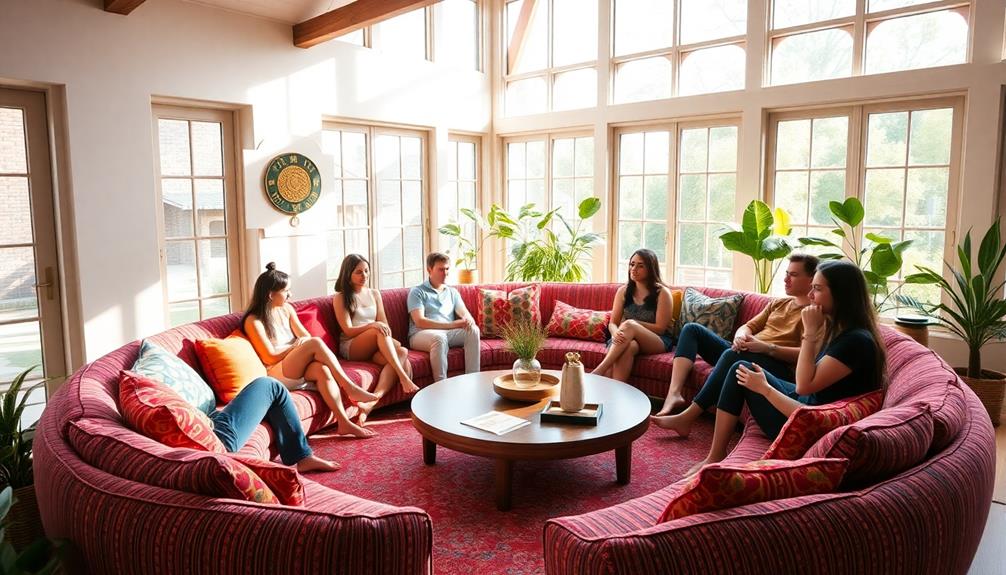
Often, the way you arrange seating can greatly enhance social interaction in your space. By opting for a circular or semi-circular seating arrangement, like positioning two sofas facing each other, you create an intimate atmosphere that encourages conversation.
Incorporating unique pieces from local artisans can also enhance the aesthetic appeal of these arrangements, making them more inviting. Adding accent chairs alongside your sofa not only diversifies your seating but also facilitates dialogue among guests while allowing for activities like watching TV.
Consider placing angled chairs across from a sofa. This setup not only adds visual interest but also promotes easy eye contact, which is essential for effective communication. Aim for a balanced layout that avoids overcrowding; leaving about three feet of walking space around seating promotes comfort and openness.
This setup invites guests to engage more freely. To further define conversation zones within larger areas, utilize area rugs. They visually group your seating arrangements, making it easier for people to gather and interact.
Optimizing Space in Small Rooms

When you're working with a small room, efficient furniture arrangement is key to making the most of your space.
Incorporating personalized design consultations can help in identifying the best layout for your needs.
Consider multi-functional design solutions, like a storage ottoman or a sofa bed, to enhance utility without sacrificing style.
With the right layout, you can create a cozy, inviting atmosphere that feels spacious and functional.
Efficient Furniture Arrangement
Maximizing space in small rooms requires a thoughtful approach to furniture arrangement that balances comfort and functionality. Start by using a single sofa as your focal point. This allows for flexible arrangements while maximizing seating without crowding the area.
Position accent chairs nearby to encourage conversation, promoting social interaction while maintaining an open flow essential for smaller spaces. Incorporating unique decor elements, such as Indonesian decor masks, can enhance the cultural richness of your space while also serving as striking conversation starters.
To further optimize your layout, use area rugs to define different zones within the room. This not only creates visual interest but also helps delineate spaces without adding bulk.
Consider incorporating floating furniture by pulling your sofa away from the walls by about 12 inches. This technique creates a more inviting atmosphere and prevents the cramped feeling that often plagues small rooms.
Additionally, think about multi-functional options, such as ottomans with built-in storage, to enhance usability. These pieces can help keep your space organized and clutter-free, allowing you to enjoy your small room to its fullest.
Multi-Functional Design Solutions
In small rooms, embracing multi-functional design solutions can transform limited space into a highly usable environment. By incorporating multi-functional furniture, like sofa beds or ottomans with storage, you can gain additional functionality without sacrificing valuable floor space. This approach enhances the efficient use of space, allowing you to adapt your room to your needs.
Additionally, the integration of eco-friendly materials in furniture design reflects a growing trend toward sustainability in modern living spaces, echoing the principles found in traditional Indonesian housing.
Utilizing vertical space is also essential. Installing shelving units or wall-mounted storage keeps the floor clear, creating an illusion of a larger area while maximizing storage capacity. Choosing furniture that serves multiple purposes, such as a coffee table that doubles as a workspace, guarantees you're making the most of your limited square footage.
Incorporating sliding or foldable furniture, like drop-leaf tables or collapsible chairs, enables quick adaptations for various activities, making small spaces more versatile.
Additionally, using strategic area rugs can help define different areas within your small room, enhancing organization and allowing for flexible layouts. By thoughtfully selecting and arranging your furnishings, you can create an efficient and functional environment that meets your lifestyle needs.
Visual Balance and Aesthetics

Achieving visual balance in a room involves distributing furniture evenly, so no area feels overcrowded or neglected. When you think about your layout, consider how each piece contributes to the overall aesthetics.
A cohesive color palette among furniture pieces enhances the room's appeal, creating a harmonious atmosphere that invites you in. Additionally, incorporating elements inspired by Indonesian wedding decor ideas can further improve the visual balance through the use of vibrant colors and intricate patterns.
Here are three key elements to focus on for visual balance:
- Accent Chairs: These can introduce texture or pattern, adding visual interest while keeping the balance intact. Choose designs that complement your existing furniture to maintain cohesion.
- Coffee Table: Verify its design complements other furniture styles. A well-chosen coffee table reinforces the room's aesthetic without overwhelming the space.
- Lighting Fixtures: Strategically placed lighting enhances the room's ambiance. Use fixtures to highlight focal points, contributing greatly to the overall visual appeal.
Common Mistakes to Avoid

When arranging your furniture, it's easy to overlook essential elements like walkway space, which can make traversing your room a hassle.
Incorporating outdoor living areas and ensuring a fluid connection between spaces can greatly enhance functionality.
You might also find yourself overcrowding the space or not defining zones effectively, leaving your layout feeling chaotic.
Avoiding these common mistakes will help you create a more functional and inviting environment.
Ignoring Walkway Space
Overlooking walkway space can throw off the entire flow of a room, leading to frustration and discomfort.
When you ignore proper spacing, your living area can quickly become cramped, making it feel smaller and less inviting.
To create a more functional and pleasant environment, consider these essential tips for maintaining walkways around your furniture:
- Maintain Three Feet of Space: Keep at least three feet of walking space around furniture to prevent collisions and guarantee easy navigation.
- Create Clear Pathways: Aim for a clear pathway of 16 to 18 inches between the sofa and coffee table. This promotes ease of movement and enhances the functionality of your open floor plan.
- Regularly Assess Layouts: Periodically evaluate and adjust your furniture placement. This helps maintain open walkways, improving both comfort and usability in the room.
Overcrowding With Furniture
One common mistake many people make is overcrowding their living rooms with too much furniture, which can severely disrupt the flow and functionality of the space. To create a comfortable environment, it's essential to maintain a three-foot walking space around furniture to allow for smooth navigation. If you push all your furniture against the walls, you may end up with a disjointed feel. Instead, consider using floating furniture to foster a cozy, inviting atmosphere.
Here's a quick overview of what to avoid:
| Mistake | Consequence | Solution |
|---|---|---|
| Overcrowding a living room | Difficult navigation and discomfort | Maintain open spaces |
| Ignoring the three-foot rule | Blocked pathways and furniture access | Keep ample clearance |
| Using bulky furniture | Cluttered and cramped feel | Choose appropriate sizes |
Lack of Defined Zones
Failing to define distinct zones in an open-plan layout can make the space feel chaotic and disorganized.
This lack of defined zones can obscure the purpose of each area, making it hard for you and your guests to identify functional areas. Overcrowding furniture in these spaces disrupts movement flow and diminishes usability.
To enhance your layout and avoid common mistakes, consider these tips:
- Use Area Rugs: Area rugs can visually separate different zones, helping maintain organization and purpose in your design.
- Create Central Voids: Be mindful of central voids; they can hinder conversation and social engagement. Guarantee seating arrangements encourage interaction.
- Establish Clear Functions: Assign specific functions to each zone, like a reading nook or a dining area, to give your space character and direction.
Essential Layout Strategies

Creating an inviting space starts with thoughtful furniture layouts that enhance both functionality and comfort. To foster conversation and connection, arrange your sofa alongside a pair of chairs, encouraging social interaction. This simple furniture arrangement helps create a welcoming atmosphere in your living room.
It's also essential to maintain clear walkways, ideally three feet wide, to guarantee comfortable navigation. This prevents collisions with furniture or walls, making your space more user-friendly.
Consider floating your furniture by pulling sofas away from walls. This technique maximizes usable floor space while adding coziness to the room.
Strategically using area rugs can further enhance your layout. They help visually segment different zones within a room, providing organization while elevating the overall aesthetic.
Zoning Techniques for Open Spaces

Open spaces can feel overwhelming, but zoning techniques can transform them into inviting, functional areas.
By effectively dividing your large living room, you create dedicated spaces that offer both purpose and breathing room.
Here are three effective zoning techniques to take into account:
- Area Rugs: Use rugs to visually separate different zones within your open space. A well-placed rug not only defines areas but also adds warmth and style.
- Consistent Styles: Choose rugs with similar styles or colors throughout the space. This unifies the design while still providing clear distinctions between functional areas.
- Strategic Furniture Placement: Position your furniture on the rugs to enhance cohesion. This creates 'rooms within rooms,' giving each area its own identity while maintaining an organized layout.
Importance of Flow and Movement

When designing your furniture layout, the flow and movement within a space play an essential role in its functionality. Prioritizing clear pathways is vital, as you should aim for at least three feet of walking space around furniture. This guarantees comfortable navigation and prevents blocked pathways that can disrupt the flow of movement in a room.
To enhance usability and accessibility, observe your daily routines to identify key routes. By doing this, you can make informed decisions about furniture placement, creating a layout that accommodates how you naturally move through the space. Maintaining open walkways not only improves the perception of spaciousness but also fosters an environment where you can move freely without obstacles.
Regularly evaluating the flow of movement in your room allows for continuous adjustments that optimize comfort and efficiency. As your needs change, revisit your layout to confirm it remains functional.
Adapting Layouts to Personal Style
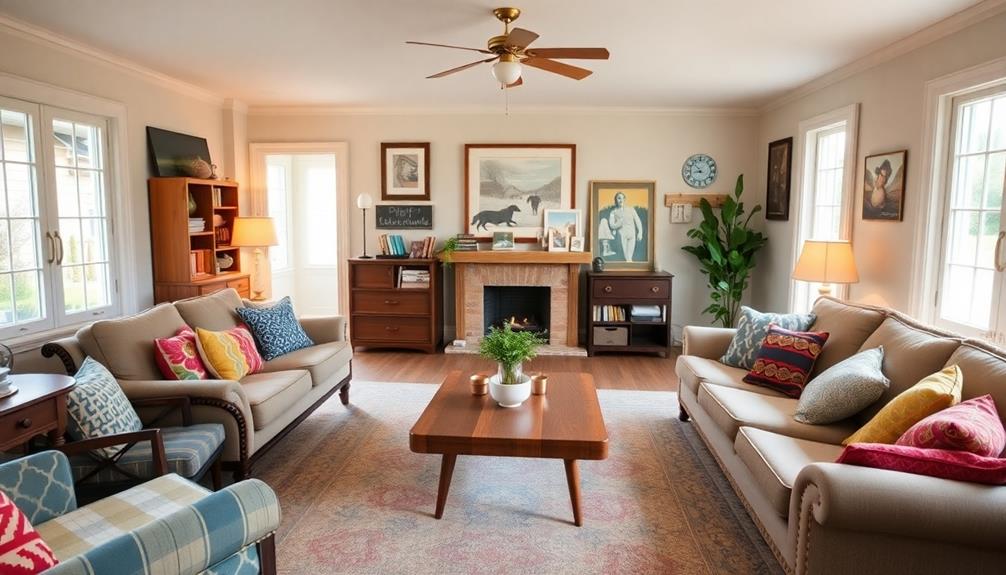
Your furniture layout should reflect your personal style, as this not only enhances the aesthetics of your space but also boosts your comfort and satisfaction.
When you adapt popular furniture layouts to fit your unique tastes, you create a cohesive environment that feels welcoming and tailored just for you.
Here are three ways to achieve that:
- Mix Styles: Combine modern and vintage pieces to create an eclectic yet functional arrangement that showcases your personality.
- Use Color and Patterns: Incorporate bold colors or distinctive patterns in your furniture and decor to make your space vibrant and engaging while maintaining functionality.
- Prioritize Comfort: Guarantee that your layout not only looks good but also promotes comfort and ease of movement, making it a true reflection of your lifestyle.
Frequently Asked Questions
What Is the 2/3 Rule Sofa?
The 2/3 Rule for sofas suggests your sofa should cover about two-thirds of the wall length it faces. This creates balance, guarantees adequate space for other furniture, and improves the room's overall flow and aesthetics.
How to Figure Out the Best Furniture Layout?
To find the best furniture layout, think of your space as a stage. Measure dimensions, visualize with apps, focus on functions, and consider focal points. Adjust regularly to suit your evolving needs and lifestyle.
Is It Better to Have Matching Furniture?
Having matching furniture can create a unified look, but it's not the only option. Mixing styles and textures adds character and depth. Consider your personal taste and the room's function to find the best balance.
Should You Put Your Couch Against the Wall?
You shouldn't always put your couch against the wall. Floating it creates a cozy atmosphere and improves flow. Consider your room's size and layout to foster intimacy and functionality, enhancing your overall living space.
Conclusion
Incorporating popular furniture layouts can transform your space into a functional, inviting haven. By enhancing room functionality, promoting social interaction, and optimizing small areas, you create a home that feels just right. Embrace zoning techniques to define spaces, maintain flow for easy movement, and adapt layouts to reflect your personal style. So, whether you're entertaining friends or enjoying quiet moments, remember that the right layout not only serves your needs but also elevates your living experience.
- About the Author
- Latest Posts
Introducing Ron, the home decor aficionado at ByRetreat, whose passion for creating beautiful and inviting spaces is at the heart of his work. With his deep knowledge of home decor and his innate sense of style, Ron brings a wealth of expertise and a keen eye for detail to the ByRetreat team.
Ron’s love for home decor goes beyond aesthetics; he understands that our surroundings play a significant role in our overall well-being and productivity. With this in mind, Ron is dedicated to transforming remote workspaces into havens of comfort, functionality, and beauty.
Southeast Asia Decor
Comparing Feng Shui Tips for Local Furniture Layouts
Feng Shui tips for local furniture layouts can transform your space—discover how small changes can lead to significant improvements in energy flow and harmony.

When comparing Feng Shui tips for local furniture layouts, focus on optimizing the flow of Chi in your spaces. Start by positioning larger furniture against solid walls for stability, and create clear pathways to encourage smooth energy movement. In the living room, arrange seating in a circular formation to enhance conversation and connection. For bedrooms, place the bed against a solid wall to promote restful sleep. Remember, decluttering is essential to avoid blocking energy flow. By following these strategies, you'll transform your home into a tranquil haven that fosters well-being—there's much more to explore on how to achieve this!
Key Takeaways
- Furniture placement should prioritize clear pathways to promote positive Chi flow and enhance overall comfort in living spaces.
- Tailor arrangements to each room's purpose, such as circular seating in living rooms for conversation and strategic bed placement in bedrooms for security.
- Use natural materials and calming colors to create inviting atmospheres and balance Yin and Yang in your decor choices.
- Regularly declutter spaces to prevent stagnant energy and maintain an inviting, harmonious environment throughout the home.
- Avoid overcrowding and misalignment with doorways to ensure smooth energy movement and enhance the welcoming nature of your living spaces.
Understanding Feng Shui Principles
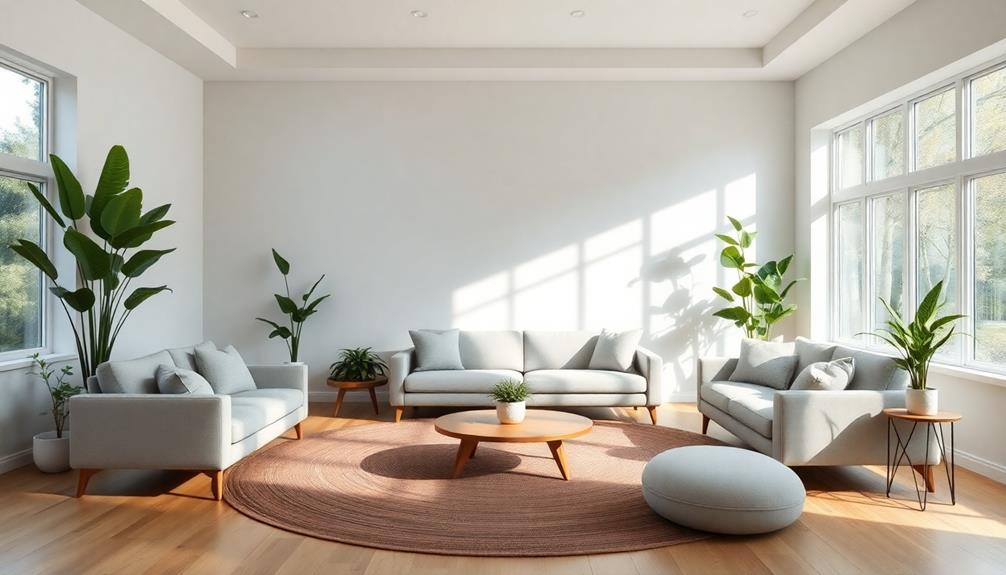
When you plunge into the world of Feng Shui, understanding its core principles is essential for creating a harmonious living space. The flow of energy, or Chi, is central to Feng Shui. You want your home to facilitate this energy's movement, so consider how furniture placement impacts this flow. Blockages can lead to stagnant energy, diminishing the positive energy in your environment.
Incorporating natural materials like wood and stone, as seen in Balinese design elements, can enhance this flow and promote a sense of tranquility.
Balancing Yin and Yang energies is significant, so pay attention to the colors and materials you choose. Warm colors can stimulate energy, while cool tones promote relaxation, making thoughtful selection crucial based on each room's purpose.
The five elements—wood, fire, earth, metal, and water—interact cyclically, promoting balance when arranged harmoniously. However, improper arrangements can create friction.
Decluttering is another key principle of Feng Shui. A tidy space enhances energy movement and clears stagnant sources, leading to a more inviting atmosphere.
Importance of Furniture Placement

When you think about furniture placement, consider how it impacts energy flow and your comfort.
The right arrangement not only enhances functionality but also creates a harmonious atmosphere where movement feels natural.
Incorporating elements of Indonesian traditional decor can further enrich the space, adding character and warmth.
Energy Flow Optimization
Furniture placement plays an essential role in maximizing energy flow within your living space. By thoughtfully arranging your furniture, you can enhance the movement of Chi, allowing positive energy to circulate freely. Incorporating culturally significant decor, such as traditional artistry like Indonesian masks, can further enrich the atmosphere of your home.
Here are some key tips to reflect on for achieving a harmonious living space:
- Avoid aligning furniture directly with doors to prevent obstructing movement.
- Position larger pieces, like sofas, against solid walls for stability.
- Choose appropriately sized furniture to avoid cluttering the space.
- Keep pathways clear to promote smooth energy flow.
- Regularly reassess your layout to maintain ideal energy dynamics.
When you strategically place your furniture, you foster a welcoming atmosphere and create a sense of security. Oversized furniture can block essential energy pathways, leading to stagnation.
Comfort and Functionality
Creating a comfortable and functional living space hinges on thoughtful furniture placement that prioritizes both aesthetics and usability. Proper arrangements enhance comfort by encouraging social interaction, making your home feel more inviting. Here's how you can achieve that balance:
| Key Considerations | Benefits |
|---|---|
| Clear Pathways | Guarantees safety and ease of movement, enhancing energy flow. |
| Proportional Sizing | Prevents cramped spaces and maintains a balanced environment. |
| Thoughtful Placement | Promotes social interaction and connection among inhabitants. |
When arranging furniture, make certain to avoid tripping hazards and awkward positioning. This not only facilitates smooth energy flow but also creates an inviting space for guests. Guarantee that furniture doesn't block doorways or windows, allowing natural light and airflow to circulate freely. Regularly assess your layout; adjusting furniture placement can help maintain the overall functionality and comfort of your living area. By prioritizing these elements, you can create a balanced environment that fosters well-being and connection, enhancing the quality of your home life considerably.
Energy Flow in Different Rooms

Achieving a harmonious energy flow in your home involves thoughtful furniture arrangements tailored to each room's purpose.
For instance, incorporating elements of traditional Indonesian style home decor can enhance the natural ambiance and promote relaxation.
Consider these essential tips for optimizing energy flow:
- Create circular seating in the living room to boost conversation and enhance energy flow.
- Position the bed in the bedroom against a solid wall for a sense of security and restful sleep.
- Place the stove in the kitchen so you can see the entrance, promoting control and positive energy during cooking.
- Use a round table in the dining room to encourage inclusivity and maintain stable energy flow.
- Incorporate natural elements like plants and wood materials to ground the atmosphere.
Living Room Layout Strategies

When arranging your living room, prioritize conversation-focused layouts that encourage connection among family and friends.
Incorporating elements from luxury tropical design aesthetics can enhance the overall ambiance, making the space feel more inviting.
Keeping pathways clear is essential, as it allows for smooth movement and maintains a positive energy flow.
Conversation-Focused Arrangements
A well-designed living room layout can transform your space into a hub of conversation and connection. By focusing on Feng Shui principles, you can enhance the energy flow and create a harmonious space for family and friends.
Incorporating elements of Indonesian wedding decor can also inspire vibrant and inviting arrangements. Here are key strategies for conversation-focused arrangements:
- Arrange sofas and chairs in a circular formation to foster interaction.
- Position seating to face each other, promoting engagement and connection.
- Use area rugs to define conversation groups and enhance intimacy.
- Avoid sharp corners and obstacles to maintain smooth energy flow.
- Incorporate a central focal point, like a coffee table or artwork, to draw attention and encourage conversation.
Pathway Clarity Importance
Clear pathways in your living room layout are crucial for maintaining a positive flow of energy, or Chi. When you prioritize pathway clarity, you facilitate smooth energy flow, allowing Chi to circulate freely and avoiding feelings of congestion or stagnation. Incorporating unique decor, such as a Face Indonesian Decor Mask, can also enhance the aesthetics of your space while promoting cultural appreciation.
If your furniture layout obstructs walkways, it can lead to frustration and disrupt the harmonious environment you desire. To create an inviting atmosphere, make certain that furniture pieces are arranged to promote easy movement. Strategically placing larger items, like sofas and chairs, away from direct pathways reduces distractions and fosters a sense of security and comfort.
This arrangement not only enhances functionality but also encourages interaction among occupants, which is crucial for building connections. Regularly evaluating and rearranging your furniture helps maintain clear pathways, preventing clutter from accumulating. By doing so, you enhance the overall well-being of your living space and promote positive energy.
Bedroom Arrangement Tips
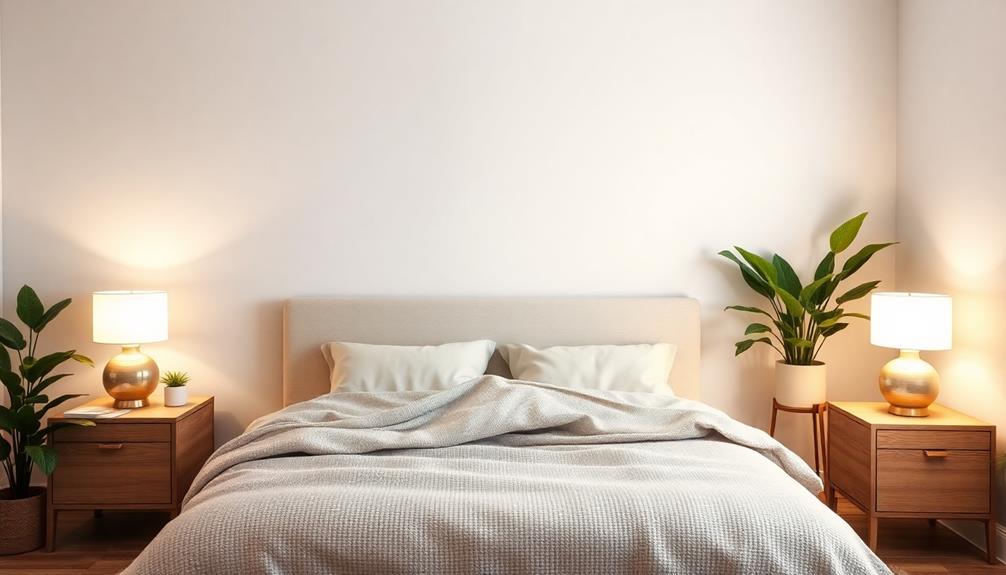
Creating a harmonious bedroom environment starts with the strategic placement of your bed. Position your bed in a commanding location, ideally against a solid wall and not directly facing the door. This arrangement enhances your feelings of security and control while you sleep.
In traditional Indonesian housing, for example, the layout often reflects spiritual elements and cultural symbolism that contribute to a sense of peace within the home, emphasizing the significance of a well-considered space for rest and rejuvenation traditional Indonesian housing.
To guarantee good feng shui, keep the space under your bed clutter-free to promote positive energy flow.
Here are some tips to optimize your bedroom arrangement:
- Choose soothing colors: Soft hues create a calming atmosphere for relaxation.
- Avoid mirrors facing the bed: They can disrupt sleep by reflecting energy and causing restlessness.
- Incorporate natural elements: Adding plants boosts vitality and well-being.
- Guarantee proper bed placement: A solid wall gives you a sense of support and stability.
- Declutter regularly: A tidy space invites peace and tranquility.
Kitchen Feng Shui Essentials

After setting up a restful bedroom, the kitchen deserves equal attention for fostering positive energy. In Feng Shui, the layout of your kitchen greatly impacts your home's overall energy flow.
Start by positioning your stove in a command position, ideally facing the entrance. This arrangement enhances your control and awareness while cooking and avoids direct confrontation with the sink, maintaining elemental harmony. For a more luxurious touch, consider integrating elements of luxury tropical designs that incorporate natural materials and vibrant colors.
Next, focus on the work triangle: the stove, sink, and refrigerator. Keeping this area balanced and unobstructed promotes efficient energy flow, making meal preparation smoother.
Verify that your dining table is centrally located and doesn't block access points, creating a welcoming environment for family gatherings.
To enhance tranquility, use natural materials and colors in your kitchen. Incorporate wooden cabinets and earth-toned accents to create a grounding atmosphere.
Regularly declutter countertops and storage areas to prevent stagnant energy. By eliminating clutter, you'll create a more inviting and functional cooking space that encourages creativity.
With these Feng Shui essentials, you'll transform your kitchen into a hub of positive energy and harmony.
Common Feng Shui Mistakes

When it comes to Feng Shui, many people unknowingly make common mistakes that can hinder the flow of positive energy in their spaces. Here are five key pitfalls to avoid:
- Overcrowding spaces with furniture creates clutter and obstructs energy flow, much like how excessive decor can detract from the beauty of Indonesian decor masks.
- Neglecting natural light leads to dark, uncomfortable environments that trap negative energy.
- Misaligning furniture with doorways blocks the welcoming energy that enters your home.
- Ignoring color choices can negatively impact your mood and the overall atmosphere.
- Failing to declutter results in stagnant energy, making your space feel chaotic.
To create a harmonious environment, focus on optimizing your furniture layout. Verify that your spaces aren't overcrowded, allowing for smooth movement and energy flow.
Pay attention to natural light; let it in to invigorate the room. Align your furniture thoughtfully with doorways and consider how colors affect your feelings and energy levels.
Regular decluttering is essential to maintaining a balanced space, as it fosters a sense of tranquility and openness.
Frequently Asked Questions
How to Arrange Furniture in Feng Shui?
To arrange furniture in Feng Shui, position larger pieces against solid walls for stability, create circular seating arrangements for connection, keep pathways clear for smooth movement, and place beds and desks facing the entrance for control.
How Do I Find the Best Furniture Layout?
To find the best furniture layout, sketch your floor plan, guarantee clear pathways, position larger pieces against walls, avoid blocking doorways, balance visual weight, and use area rugs to define conversation zones effectively.
What Is the Best Layout for Feng Shui?
When it comes to Feng Shui, you'll want to create a space that flows smoothly. Arrange furniture to encourage conversation, position your bed for security, and incorporate natural elements for a harmonious, inviting atmosphere.
How Do You Arrange Furniture for Positive Energy?
To arrange furniture for positive energy, place sofas and chairs in circular or U-shaped layouts, avoid blocking doorways, maintain clear pathways, position key pieces to face entrances, and incorporate natural elements like plants for liveliness.
Conclusion
Just like a river flows freely through a forest, your home should allow energy to move smoothly. When you embrace the principles of feng shui, you're not just arranging furniture; you're crafting a harmonious environment that nurtures your spirit. Avoid the rocks that block your path—common mistakes in placement can disrupt the flow. By thoughtfully considering each space, you're creating a sanctuary where energy thrives, much like a garden blossoming under the sun.
- About the Author
- Latest Posts
Introducing Ron, the home decor aficionado at ByRetreat, whose passion for creating beautiful and inviting spaces is at the heart of his work. With his deep knowledge of home decor and his innate sense of style, Ron brings a wealth of expertise and a keen eye for detail to the ByRetreat team.
Ron’s love for home decor goes beyond aesthetics; he understands that our surroundings play a significant role in our overall well-being and productivity. With this in mind, Ron is dedicated to transforming remote workspaces into havens of comfort, functionality, and beauty.
-

 Vetted58 minutes ago
Vetted58 minutes ago15 Best Boxwood Varieties for Thriving in Full Sunlight
-

 Vetted3 days ago
Vetted3 days ago15 Best Ways to Label Clothes for Nursing Home Residents – Stay Organized and Efficient
-

 Vetted1 day ago
Vetted1 day ago15 Best Dryer Vent Hoses to Keep Your Laundry Room Safe and Efficient
-

 Vetted1 day ago
Vetted1 day ago15 Best Spider Sprays to Keep Your Home Arachnid-Free
-

 Vetted2 hours ago
Vetted2 hours ago14 Best Cleaners for Aluminum Surfaces – Shine Bright Like a Diamond
-

 Vetted1 day ago
Vetted1 day ago15 Best Nightstand Charging Stations to Keep Your Devices Organized and Ready to Go
-

 Vetted3 days ago
Vetted3 days ago15 Best Beer Fridges to Keep Your Brews Cold and Ready to Enjoy
-
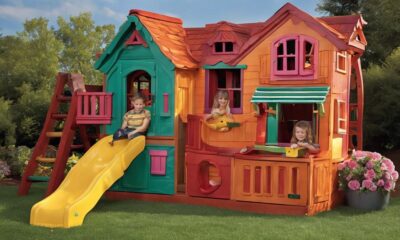
 Vetted1 day ago
Vetted1 day ago15 Best Outdoor Playhouses That Will Transform Your Backyard Fun














